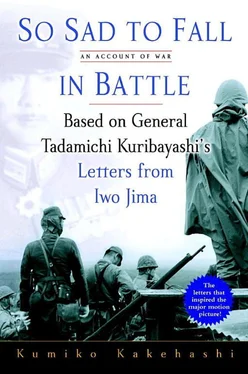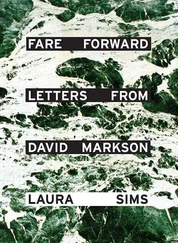During the invasion of Saipan, Smith had criticized the officer leading an army division placed under his overall command for “[lacking] aggressive spirit,” and had the officer in question relieved of his command in the middle of the battle, which ignited an acrimonious dispute. He explained that he could not look on in silence while the lives of “my marines” (as he called them) were sacrificed by faint-hearted cowards. An insistence on sharing equally in the joys and sorrows of his men and a detestation of political maneuvering were characteristics that he and Kuribayashi shared.
Smith was well-known for his foul mouth, and while he calls Admiral Nimitz an opportunist in his memoirs, he does not stint in his praise for Kuribayashi.
Of all our adversaries in the Pacific, Kuribayashi was the most redoubtable. Some Japanese island commanders were just names to us, and disappeared into the anonymity of enemy corpses left for burial parties. Kuribayashi’s personality was written deep in the underground defenses he devised for Iwo Jima.
There is no one better qualified to judge a general than the enemy general he is fighting. They may never actually meet, but seeing how their counterparts fight in the extremes of battle gives them a sense not just of their abilities, but of their character and their humanity.
Lieutenant General Smith chose to compare the almost uncanny resilience of the underground defenses at Iwo Jima to a worm, and the comparison certainly encapsulates Kuribayashi’s down-to-earth realism—his indifference to glory and to the conventional values of the Japanese warrior class—as well as the extraordinary strength of his will.
—
THE UNDERGROUND INSTALLATIONS showed their worth even before the battle started. They protected the soldiers from the massive bombardments inflicted on the island as a softening-up before the ground assault.
On December 8, 1944—almost three years to the day after the Japanese attack on Pearl Harbor—Iwo Jima was hit by the biggest combined aerial assault and naval bombardment since the start of the Pacific War. For the Americans it was the anniversary of their humiliation.
Kuribayashi wrote a letter to his wife that same afternoon.
After touching on the usual everyday topics—“I told you before that I don’t need you to send me whiskey or anything else and I really don’t, so there’s no need to worry about it;” and “I should be getting paid an end-of-year bonus (2,650 yen, I think). It’s a bore that no matter how much I get given there’s no way to spend it here.” He goes on:
It’s December 8 today. Just as I expected, we were attacked by large planes that came in thirteen waves from around 8:30 in the morning until about 1:00 in the afternoon. They were followed by a naval bombardment lasting one and a half hours, and I only just came out of the shelter now (3:00 p.m.).
Bombs landed quite close to us, but luckily they didn’t do any damage. The overall number of casualties is tiny.
On this single day, a combined total of 192 fighters and bombers flew over Iwo Jima and dropped more than 800 tons of bombs. Three heavy cruisers and six destroyers fired a naval barrage of 6,800 shells. Aboveground, the Japanese lost 10 planes, but the underground installations were untouched, and casualties were almost nonexistent.
Up to that point the island had been bombarded in fits and starts, but from December 8 until the landing, the bombardment continued for seventy-four days without a single day’s pause. Lieutenant General Smith and the rest of the American leadership were amazed that, despite a greater quantity and density of shells than at any other battleground in the Pacific War, the defensive positions continued to strengthen and increase in number over that period.
The Japanese soldiers would all dive underground when air raids and naval bombardments started, but when they were over, they would come back aboveground and resume their work. The intense bombardment had destroyed every single tree and blade of grass, but their underground world was unharmed.
According to the official history of the U.S. Marine Corps, a total of 6,800 tons of bombs were dropped on the island over the seventy-four-day period. In the five naval bombardments conducted in December and January, 203 16-inch shells, 6,472 8-inch shells, and 15,251 5-inch shells were fired. As far as the Americans were concerned, so intense was the bombardment that they wouldn’t have been surprised if the island had simply ceased to exist. But the aerial photographs taken by reconnaissance planes told a different story: the 450 defense positions that had been in place when the bombardment started had increased to 750 just before the landings.
After the war, in his book The Great Sea War , Nimitz said:
The Seventh Air Force B-24 squadron based in the Mariana Islands carried out continuous air raids for 74 days in preparation for the coming assault. These air raids only served to make the Japanese even more industrious in their efforts to complete their underground defenses….
The Marine commanders were well-known for their toughness and experience but they were flabbergasted when they saw the meticulous preparations of Kuribayashi’s garrison in the aerial photographs.
Despite their lack of materials and drinking water, the Japanese soldiers on Iwo Jima had built a defense network strong enough to make the frontline commanders of the U.S. forces anxious.
The Americans nonetheless believed that five days would be enough to conquer the island.
On February 16, three days before the invasion, a press conference for seventy war correspondents was held on the command ship USS Eldorado. Marine Brigadier General William W. Rogers predicted that the Japanese army would put up a strong initial defense at the beach in an effort to keep the Americans from landing. He also said that the Japanese were sure to make a coordinated nighttime counterattack—a banzai charge ending in certain death—some time in the first night after the landing. The Japanese that the marines had fought so far in the Pacific had all followed that pattern up until now.
The Americans expected to take high casualties on the beach, but thought that if they could stick it out, everything would go their way.
The Americans were wrong.
From February 16 to February 18, the American forces pummeled Iwo Jima with naval guns and with planes, in preparation for the landing. After the war, Takahashi Toshiharu, a survivor who served as corporal in the First Mixed Brigade of Engineers, wrote a faithful account of his experiences on Iwo Jima based on his diary and notes. He wanted to forget what had happened to him on the island, but he also felt that it would be wrong to just consign it to oblivion. Of the 278 people in his unit, only 13 survived.
After Takahashi died in 1986, the notebook in which he had written his account was left in the hands of his family. It includes a description of the awesome three-day naval bombardment.
The guns that were trained on the island all spurted fire at the same time. On the island there was a huge earthquake.
There were pillars of fire that looked as if they would touch the sky. Black smoke covered the island, and shrapnel was flying all over the place with a shrieking sound. Trees with trunks one meter across were blown out of the ground, roots uppermost. The sound was deafening, as terrible as a couple of hundred thunderclaps coming down at once.
Even in a cave thirty meters underground, my body was jerked up off the ground. It was hell on earth.
The naval barrage was followed by a truly apocalyptic air raid. The explosions were so fierce that a quarter of the summit of Mount Suribachi was blown off.
Next, large planes—many tens of them—came all together. They made a deep rumbling sound as they came. They were silver. Once over the island they dropped one-ton bombs—terrifying things. The sound they made as they fell, one after another, was terrifying. A timid man would go insane.
Читать дальше












